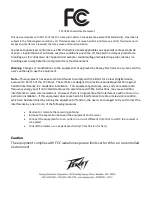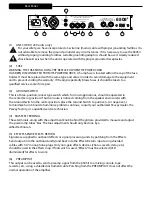
position activates the Lead Channel. The red LED next to the Lead Pre control will illuminate to
indicate that the Lead Channel is active. In the “out” position, the Rhythm channel is activated
and the green LED illuminates next to the Rhythm Pre control to indicate that the Rhythm Channel is
active. Channels may be remotely selected using the 6505 II’s footswitch. If remote selection is
desired, the Channel Select Switch must be set to the “in” position (Lead Channel).
(14) CHANNEL SELECT LED
Both the Rhythm Channel and Lead Channel have these LEDs to indicate which channel is active. The
two Channel Select LEDs are never on at the same time. The channel with its indicator illuminated
is the active channel.
(15/18) PRE and POST GAIN
The channel Pre (15) and Post (18) Gain controls operate in the same manner for both channels.
However, the Lead channel does have more pregain than the Rhythm Channel. In most applications, the
Rhythm channel should be set up with the Pre Gain at the lower “cleaner” settings (0-4) and the
Post Gain should be set for overall volume. The Rhythm channel can be converted to a medium
distortion channel by activating the Crunch switch (17). This will more closely match the pre gain
of the two channels. The Lead channel should be set up with the Pre Gain at the mid to upper
settings (5-10) and the Post Gain should be set for overall volume.
(19/20/21) EQUALIZATION
The 6505 II’s equalization block features passive low, mid, and high EQ that is custom tailored for
each channel to classic Peavey specifications. Adjusting the control(s) counterclockwise will
result in an attenuation of the signal within the frequency band.
(16) BRIGHT SWITCH
Activates a preset boost in the treble frequencies (6 dB at 2 kHz) and affects only the Rhythm
Channel.
(17) CRUNCH SELECT SWITCH
Boosts the gain of the Rhythm channel to create a medium distortion or in between tone. Depress to
the “in” position to activate.
(22/2) RESONANCE / PRESENCE
Unique to Peavey instrument amplifiers, the Resonance control (22) can be set to boost the gain of
the power amp in the low frequencies at the resonance/attenuation point of the speaker cabinet. In
simple terms, the Resonance control works like a low EQ to offset low- end frequency drop out. The
Presence control (23) works in the same manner, boosting the high frequencies. Experimentation
using your particular speaker cabinet, along with personal taste, will determine your setting for these impor-
tant controls.



























